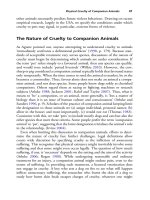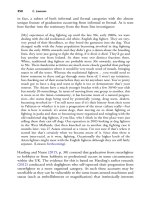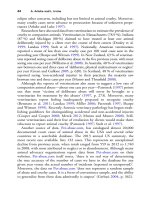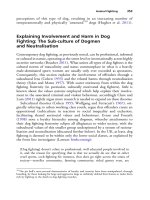The palgrave international handbook of a 193
Bạn đang xem bản rút gọn của tài liệu. Xem và tải ngay bản đầy đủ của tài liệu tại đây (26.76 KB, 1 trang )
186
N. Taylor and H. Fraser
. . . our society is founded upon animal consumption and use, and people are
blinded to the horror of this. Packaging meat in a way that does not look like
an animal separates the consumer from the fact the product contains what was
once a living creature with feelings, family, and a community. This encourages
a mental and emotional disconnect, and creates enormous alienation both from
the self and from nature.
Yet, the idea that animal abuse is normative and institutionalised through
animal slaughter can be difficult to fully grasp as it forces us to look at such
abuse not as an aberration but as constitutive of modern society. Digging
underneath the human respectability afforded modern societal life can feel
destabilising. Even members of the committed left, outside human–animal
studies circles, might find it hard to comprehend the crude barbarism that
lies behind our human lives of fast-paced work and travel, our lust for
electronic devices and pride in high-tech health products. Rather than face
the slaughter of animals the argument might be that such a focus is an
indulgence, given the scale of problems facing humans across the world.
Recognising (Animal) Abuse beyond Individual
Acts of Intended Cruelty
As humans, especially those of us in the West, we are encouraged to think
about violence predominantly as an individual and intentional, if not
psychotic affair. We see this in the media reports that concentrate on the
individual perpetrator, his psyche, childhood and more recently, the
possible triggers to the outburst. This lone psychotic focus occurs even
when there are mass killings, such as gunmen opening fire on people in
cinemas, shopping centres or schools (Kimmel 2013). Less frequently,
attention is given to groups of people involved in violence. Sometimes,
blame for this violence is attributed to the entire group, irrespective of
perpetrators or victims, as in theories about cultures of violence, sometimes attributed to racially profiled groups (see Birzer 2012); groups that
have a history of being likened to animals.
Seriously facing the scale and extent of animal slaughter takes us into some
difficult and uncomfortable terrain. For example, Cantor (2014, p. 29) draws
parallels between mass animal slaughter and human genocide when he argues
that ‘Such institutionalized atrocities as the American Holocaust and human
slavery derive from the logic inherent in humanism that any kind of animal,
including human animals, can be less than human’. This idea picks up on









